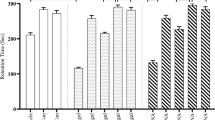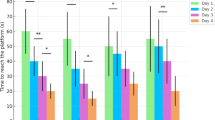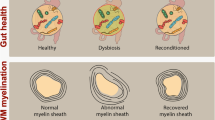Abstract
Curcumin, a yellow-pigment compound found in the popular Indian spice turmeric (Curcuma longa), has been extensively investigated for its anti-inflammatory, chemopreventative, and antidepressant properties. Here, we examined the efficacy of dietary curcumin at impairing the consolidation and reconsolidation of a Pavlovian fear memory, a widely studied animal model of traumatic memory formation in posttraumatic stress disorder (PTSD). We show that a diet enriched with 1.5% curcumin prevents the training-related elevation in the expression of the immediate early genes (IEGs) Arc/Arg3.1 and Egr-1 in the lateral amygdala (LA) and impairs the ‘consolidation’ of an auditory Pavlovian fear memory; short-term memory (STM) is intact, whereas long-term memory (LTM) is significantly impaired. Next, we show that dietary curcumin impairs the ‘reconsolidation’ of a recently formed auditory Pavlovian fear memory; fear memory retrieval (reactivation) and postreactivation (PR)-STM are intact, whereas PR-LTM is significantly impaired. Additional experiments revealed that dietary curcumin is also effective at impairing the reconsolidation of an older, well-consolidated fear memory. Furthermore, we observed that fear memories that fail to reconsolidate under the influence of dietary curcumin are impaired in an enduring manner; unlike extinguished fear memories, they are not subject to reinstatement or renewal. Collectively, our findings indicate that a diet enriched with curcumin is capable of impairing fear memory consolidation and reconsolidation processes, findings that may have important clinical implications for the treatment of disorders such as PTSD that are characterized by unusually strong and persistently reactivated fear memories.
Similar content being viewed by others
Log in or create a free account to read this content
Gain free access to this article, as well as selected content from this journal and more on nature.com
or
References
Aggarwal BB, Shishodia S (2006). Molecular targets of dietary agents for prevention and therapy of cancer. Biochem Pharmacol 71: 1397–1421.
Aggarwal BB, Harikumar KB (2009). Potential therapeutic effects of curcumin, the anti-inflammatory agent, against neurodegenerative, cardiovascular, pulmonary, metabolic, autoimmune and neoplastic diseases. Int J Biochem Cell Biol 41: 40–59.
Aggarwal BB, Sundaram C, Malani N, Ichikawa H (2007). Curcumin: the Indian solid gold. Adv Exp Med Biol 595: 1–75.
Alberini CM (2005). Mechanisms of memory stabilization: are consolidation and reconsolidation similar or distinct processes? Trends Neurosci 28: 51–56.
Anand P, Kunnumakkara AB, Newman RA, Aggarwal BB (2007). Bioavailability of curcumin: problems and promises. Mol Pharm 4: 807–818.
Baeuerle PA, Henkel T (1994). Function and activation of NF-kappa B in the immune system. Annu Rev Immunol 12: 141–179.
Balasubramanyam K, Varier RA, Altaf M, Swaminathan V, Siddappa NB, Ranga U et al (2004). Curcumin, a novel p300/CREB-binding protein-specific inhibitor of acetyltransferase, represses the acetylation of histone/nonhistone proteins and histone acetyltransferase-dependent chromatin transcription. J Biol Chem 279: 51163–51171.
Berger W, Mendlowicz MV, Marques-Portella C, Kinrys G, Fontenelle LF, Marmar CR et al (2009). Pharmacologic alternatives to antidepressants in posttraumatic stress disorder: a systematic review. Prog Neuropsychopharmacol Biol Psychiatry 33: 169–180.
Bhutani MK, Bishnoi M, Kulkarni SK (2009). Anti-depressant like effect of curcumin and its combination with piperine in unpredictable chronic stress-induced behavioral, biochemical and neurochemical changes. Pharmacol Biochem Behav 92: 39–43.
Bouton ME, Bolles RC (1979). Contextual control of the extinction of conditioned fear. Learn Motiv 10: 445–466.
Bouton ME, Ricker ST (1994). Renewal of extinguished responding in a second context. Animal Learn Behav 22: 317–324.
Brady K, Pearlstein T, Asnis GM, Baker D, Rothbaum B, Sikes CR et al (2000). Efficacy and safety of sertraline treatment of posttraumatic stress disorder: a randomized controlled trial. JAMA 283: 1837–1844.
Bremner P, Heinrich M (2002). Natural products as targeted modulators of the nuclear factor-kappaB pathway. J Pharm Pharmacol 54: 453–472.
Chen L, Fischle W, Verdin E, Greene WC (2001). Duration of nuclear NF-kappaB action regulated by reversible acetylation. Science 293: 1653–1657.
Davidson J, Pearlstein T, Londborg P, Brady KT, Rothbaum B, Bell J et al (2001a). Efficacy of sertraline in preventing relapse of posttraumatic stress disorder: results of a 28-week double-blind, placebo-controlled study. Am J Psychiatry 158: 1974–1981.
Davidson JR, Rothbaum BO, van der Kolk BA, Sikes CR, Farfel GM (2001b). Multicenter, double-blind comparison of sertraline and placebo in the treatment of posttraumatic stress disorder. Arch Gen Psychiatry 58: 485–492.
Debiec J, LeDoux JE (2004). Disruption of reconsolidation but not consolidation of auditory fear conditioning by noradrenergic blockade in the amygdala. Neuroscience 129: 267–272.
Dudai Y, Eisenberg M (2004). Rites of passage of the engram: reconsolidation and the lingering consolidation hypothesis. Neuron 44: 93–100.
Duvarci S, Nader K (2004). Characterization of fear memory reconsolidation. J Neurosci 24: 9269–9275.
Heim C, Nemeroff CB (2009). Neurobiology of posttraumatic stress disorder. CNS Spectr 14: 13–24.
Hurley LL, Akinfiresoye L, Nwulia E, Kamiya A, Kulkarni AA, Tizabi Y (2013). Antidepressant-like effects of curcumin in WKY rat model of depression is associated with an increase in hippocampal BDNF. Behav Brain Res 239: 27–30.
Jagetia GC, Aggarwal BB (2007). “Spicing up” of the immune system by curcumin. J Clin Immunol 27: 19–35.
Jobin C, Bradham CA, Russo MP, Juma B, Narula AS, Brenner DA et al (1999). Curcumin blocks cytokine-mediated NF-kappa B activation and proinflammatory gene expression by inhibiting inhibitory factor I-kappa B kinase activity. J Immunol 163: 3474–3483.
Kessler RC, Petukhova M, Sampson NA, Zaslavsky AM, Wittchen HU (2012). Twelve-month and lifetime prevalence and lifetime morbid risk of anxiety and mood disorders in the United States. Int J Methods Psychiatr Res 21: 169–184.
Kindt M, Soeter M, Vervliet B (2009). Beyond extinction: erasing human fear responses and preventing the return of fear. Nat Neurosci 12: 256–258.
Kulkarni S, Dhir A, Akula KK (2009). Potentials of curcumin as an antidepressant. ScientificWorld Journal 9: 1233–1241.
Kulkarni SK, Dhir A (2010). An overview of curcumin in neurological disorders. Indian J Pharm Sci 72: 149–154.
Lubin FD, Sweatt JD (2007). The IkappaB kinase regulates chromatin structure during reconsolidation of conditioned fear memories. Neuron 55: 942–957.
Maddox SA, Schafe GE (2011a). The activity-regulated cytoskeletal-associated protein (Arc/Arg3.1) is required for reconsolidation of a Pavlovian fear memory. J Neurosci 31: 7073–7082.
Maddox SA, Schafe GE (2011b). Epigenetic alterations in the lateral amygdala are required for reconsolidation of a Pavlovian fear memory. Learn Mem 18: 579–593.
Maddox SA, Monsey MS, Schafe GE (2011). Early growth response gene 1 (Egr-1) is required for new and reactivated fear memories in the lateral amygdala. Learn Mem 18: 24–38.
Maddox SA, Watts CS, Schafe GE (2013). p300/CBP histone acetyltransferase activity is required for newly acquired and reactivated fear memories in the lateral amygdala. Learn Mem 20: 109–119.
Mahan AL, Ressler KJ (2012). Fear conditioning, synaptic plasticity and the amygdala: implications for posttraumatic stress disorder. Trends Neurosci 35: 24–35.
Malkani S, Rosen JB (2000). Specific induction of early growth response gene 1 in the lateral nucleus of the amygdala following contextual fear conditioning in rats. Neuroscience 97: 693–702.
Malkani S, Wallace KJ, Donley MP, Rosen JB (2004). An egr-1 (zif268) antisense oligodeoxynucleotide infused into the amygdala disrupts fear conditioning. Learn Mem 11: 617–624.
Maren S (2011). Seeking a spotless mind: extinction, deconsolidation, and erasure of fear memory. Neuron 70: 830–845.
Maren S, Quirk GJ (2004). Neuronal signalling of fear memory. Nat Rev Neurosci 5: 844–852.
Milad MR, Rauch SL, Pitman RK, Quirk GJ (2006). Fear extinction in rats: implications for human brain imaging and anxiety disorders. Biol Psychol 73: 61–71.
Monsey MS, Ota KT, Akingbade IF, Hong ES, Schafe GE (2011). Epigenetic alterations are critical for fear memory consolidation and synaptic plasticity in the lateral amygdala. PLoS One 6: e19958.
Nader K, Schafe GE, LeDoux JE (2000). Fear memories require protein synthesis in the amygdala for reconsolidation after retrieval. Nature 406: 722–726.
Pavlov IP (1927) Conditioned Reflexes. Oxford University Press: London.
Pitman RK, Rasmusson AM, Koenen KC, Shin LM, Orr SP, Gilbertson MW et al (2012). Biological studies of post-traumatic stress disorder. Nat Rev Neurosci 13: 769–787.
Ploski JE, Pierre VJ, Smucny J, Park K, Monsey MS, Overeem KA et al (2008). The activity-regulated cytoskeletal-associated protein (Arc/Arg3.1) is required for memory consolidation of pavlovian fear conditioning in the lateral amygdala. J Neurosci 28: 12383–12395.
Prasad S, Tyagi AK, Aggarwal BB (2014). Recent developments in delivery, bioavailability, absorption and metabolism of curcumin: the golden pigment from golden spice. Cancer Res Treat 46: 2–18.
Quirk GJ, Pare D, Richardson R, Herry C, Monfils MH, Schiller D et al (2010). Erasing fear memories with extinction training. J Neurosci 30: 14993–14997.
Rodrigues SM, Schafe GE, LeDoux JE (2004). Molecular mechanisms underlying emotional learning and memory in the lateral amygdala. Neuron 44: 75–91.
Sandkuhler J, Lee J (2013). How to erase memory traces of pain and fear. Trends Neurosci 36: 343–352.
Sanmukhani J, Satodia V, Trivedi J, Patel T, Tiwari D, Panchal B et al (2013). Efficacy and safety of curcumin in major depressive disorder: a randomized controlled trial. Phytother Res 28: 579–585.
Schafe GE, Nader K, Blair HT, LeDoux JE (2001). Memory consolidation of Pavlovian fear conditioning: a cellular and molecular perspective. Trends Neurosci 24: 540–546.
Sears RM, Schiff HC, LeDoux JE (2014). Molecular mechanisms of threat learning in the lateral nucleus of the amygdala. Prog Mol Biol Transl Sci 122: 263–304.
Si J, Yang J, Xue L, Yang C, Luo Y, Shi H et al (2012). Activation of NF-kappaB in basolateral amygdala is required for memory reconsolidation in auditory fear conditioning. PLoS One 7: e43973.
Tronson NC, Taylor JR (2007). Molecular mechanisms of memory reconsolidation. Nat Rev Neurosci 8: 262–275.
Xu Y, Ku BS, Yao HY, Lin YH, Ma X, Zhang YH et al (2005a). The effects of curcumin on depressive-like behaviors in mice. Eur J Pharmacol 518: 40–46.
Xu Y, Ku BS, Yao HY, Lin YH, Ma X, Zhang YH et al (2005b). Antidepressant effects of curcumin in the forced swim test and olfactory bulbectomy models of depression in rats. Pharmacol Biochem Behav 82: 200–206.
Xu Y, Ku B, Tie L, Yao H, Jiang W, Ma X et al (2006). Curcumin reverses the effects of chronic stress on behavior, the HPA axis, BDNF expression and phosphorylation of CREB. Brain Res 1122: 56–64.
Xu Y, Lin D, Li S, Li G, Shyamala SG, Barish PA et al (2009). Curcumin reverses impaired cognition and neuronal plasticity induced by chronic stress. Neuropharmacology 57: 463–471.
Yeh SH, Lin CH, Gean PW (2004). Acetylation of nuclear factor-kappaB in rat amygdala improves long-term but not short-term retention of fear memory. Mol Pharmacol 65: 1286–1292.
Yehuda R (2002). Post-traumatic stress disorder. N Engl J Med 346: 108–114.
Yehuda R, LeDoux J (2007). Response variation following trauma: a translational neuroscience approach to understanding PTSD. Neuron 56: 19–32.
Zovkic IB, Sweatt JD (2013). Epigenetic mechanisms in learned fear: implications for PTSD. Neuropsychopharmacology 38: 77–93.
Acknowledgements
We thank Dr Kristie T Ota for help with the corticosterone assay. Glenn E Schafe has been funded by the National Institute of Mental Health (MH 073949), the Center for Translational and Basic Research (CTBR) at Hunter College (National Institute of Minority Health and Health Disparities Grant MD 007599), and by Yale University. Melissa S Monsey was supported by an American Psychological Association Dissertation Award during this project.
Author information
Authors and Affiliations
Corresponding author
Additional information
Supplementary Information accompanies the paper on the Neuropsychopharmacology website
Supplementary information
Rights and permissions
About this article
Cite this article
Monsey, M., Gerhard, D., Boyle, L. et al. A Diet Enriched with Curcumin Impairs Newly Acquired and Reactivated Fear Memories. Neuropsychopharmacol 40, 1278–1288 (2015). https://doi.org/10.1038/npp.2014.315
Received:
Revised:
Accepted:
Published:
Issue date:
DOI: https://doi.org/10.1038/npp.2014.315
This article is cited by
-
Inflammatory and oxidative stress markers in post-traumatic stress disorder: a systematic review and meta-analysis
Molecular Psychiatry (2022)
-
A diet enriched with curcumin promotes resilience to chronic social defeat stress
Neuropsychopharmacology (2019)
-
The Naturally Occurring Compound Garcinia Indica Selectively Impairs the Reconsolidation of a Cocaine-Associated Memory
Neuropsychopharmacology (2017)



